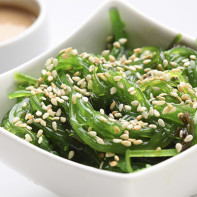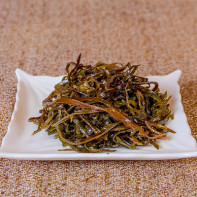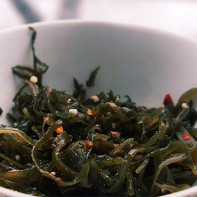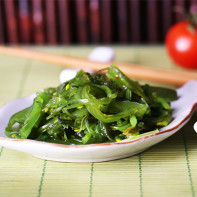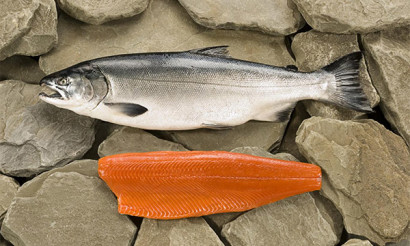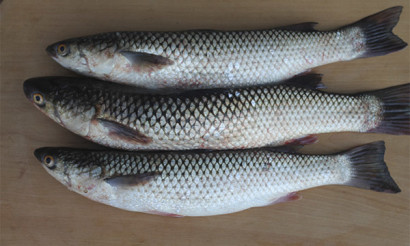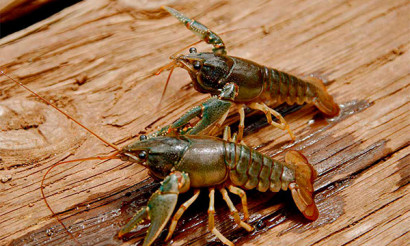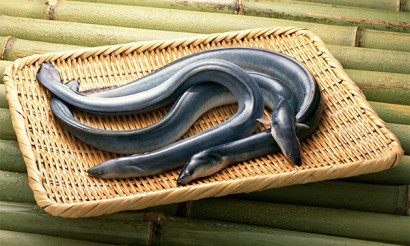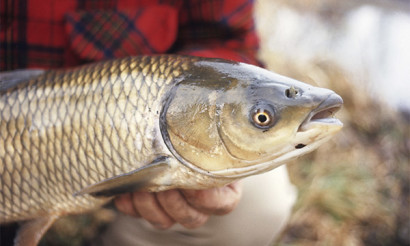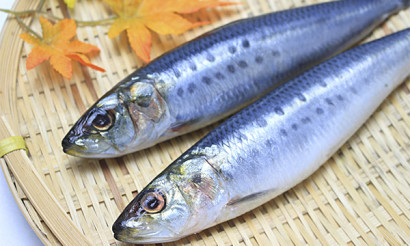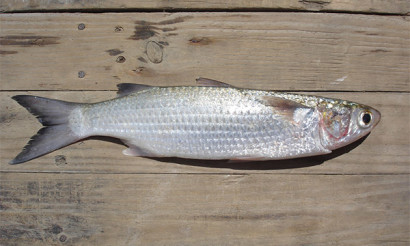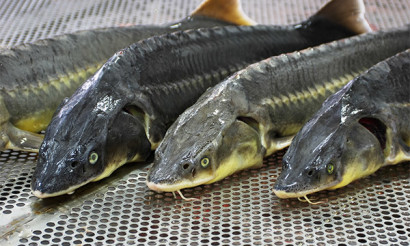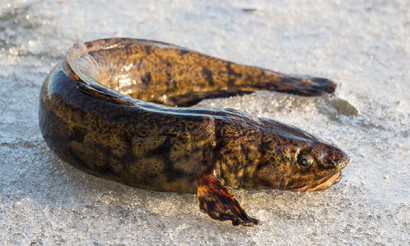Sea kale: benefits and harms to the body
The healing properties of seaweed have been known for a long time. However, in Western cuisine, this product has still not received due recognition. Meanwhile, seaweed is available and nutritious; it supplies the body with many vitamins, minerals and other beneficial substances.
- What is seaweed
- Kinds
- What is the difference between seaweed and chucks
- Composition and calorie content
- What is useful seaweed
- General benefit
- For women
- For men
- During pregnancy
- When breastfeeding
- For kids
- Seaweed chips: benefits and harms
- Is canned seaweed useful?
- The benefits and harms of dried seaweed
- Is it possible to eat sea kale for weight loss
- Seaweed in medicine
- With diabetes
- With pancreatitis
- With gastritis
- For the intestines
- For constipation
- With gout
- With colitis
- For the liver
- With hemorrhoids
- With cholecystitis
- Seaweed based traditional medicine recipes
- Seaweed in cosmetology
- For face
- For hair
- Harm and contraindications
- Symptoms of seaweed allergy
- How to choose and store seaweed
- Is it possible to freeze
- How to dry seaweed
- How to cook seaweed: recipes
- Salad with seaweed, potatoes and eggs
- Frozen Seaweed Salad
- Pickle with seaweed
- Omelet with cabbage
- How to eat seaweed
- How much can you eat per day
- Can I eat at night
- Is it possible to eat raw
- Is it possible to eat sea kale in the post
- Is it possible to give animals seaweed
- Interesting facts about seaweed
What is seaweed
Seaweed is a product obtained from brown seaweed - kelp, for example, Laminaria japonica Aresh, L. saccharica L. These algae are found mainly in the Pacific Ocean, so the product is popular in the Far East, in the traditional cuisine of China and Japan. However, in these countries, seaweed is also a remedy.
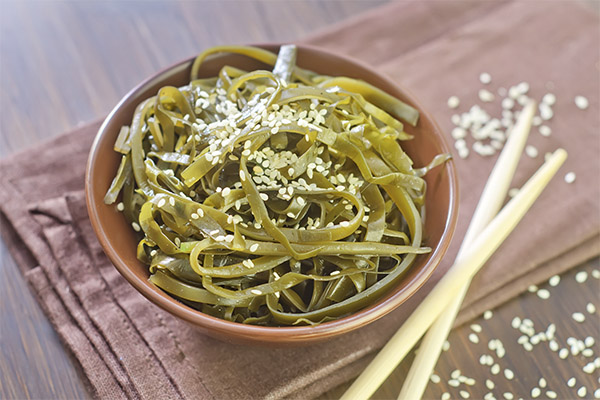
Kinds
About 30 species of kelp are found in nature, although not all of them can be eaten because of an unpleasant smell or taste. Three main types are used to supply sea kale to the market:
- Japanese kelp, which is considered the most valuable in terms of chemical composition. Medicines are also made from this type of algae.
- Sugar kelp. It is found mainly in the White, Kara and Barents Sea. In composition, it is inferior to Japanese, in taste it is less pleasant, but it is often used for canning with various additives.
- Laminaria digitata. It has a bitter-salty taste. It is rarely used in cooking, but it has found widespread use in pharmacology, where it is used to produce drugs against atherosclerosis.
Sea kale can be divided into two large groups - those species that are used in medicine, and those that are eaten. In addition to taste, they also differ in iodine content.
As for ready-made seaweed, used for food purposes, it is also produced in several forms - frozen, canned (pickled) and dried.
What is the difference between seaweed and chucks
Many believe that seaweed and chuka are one and the same. In fact, chuka is a ready-made dish, a salad. Moreover, in Russia and the countries of the Far East, this concept has a slightly different meaning.
It should be noted that chuka salad is a dish of Japanese cuisine. The word chuka means Chinese. And this is not just one dish, but the most different types of salads, and they have one thing in common - their ingredients are cut into thin strips. Moreover, cucumbers are often used from vegetables, sometimes carrots, meat and ham can also be added to it, and also transparent rice noodles to harusame. Refueling is done on the basis of vinegar and sesame oil.Also, Kikurage wood mushrooms are sometimes added to the dish. There are no seaweed in these salads.
In Russia, “chuka” is a seaweed salad, which in Japan is called “kaiso sarada”. But it does not contain sea kale, it is based on wakame seaweed (the botanical name is Undaria pinnate), which has a pleasant delicate taste. What they have in common with sea kale is that both products belong to the category of brown algae and are cut into strips. By the way, Japanese cabbage is called “combo” in Japanese, it is added to miso soup and even tea is brewed on its basis.
Composition and calorie content
Sea kale is a low-calorie product. Its energy value is only 49 kcal per 100 g of product.
But the main thing in it is its chemical composition. Laminaria is considered one of the best natural sources of iodine. Research shows that 1 kg of seaweed contains as much of this element as 100 thousand liters of sea water. That is why kelp is useful for those who suffer from certain diseases of the thyroid gland, since iodine deficiency leads to significant disturbances in the endocrine system. It is enough to simply compare the figures: the daily need for iodine for a healthy person is 100-150 mcg. A portion of dry kelp (100 g) contains up to 160–800 mg of this element.
Seaweed in addition to iodine contains:
- Vitamins B1, B2 and B12, useful for metabolic processes and central nervous system activity.
- Pantothenic acid (vitamin B5), which is often called anti-stress vitamin - it is necessary for the normal production of adrenal hormones, the formation of antibodies and the strengthening of the vascular system, the normal absorption of other vitamins.
- Folic acid (vitamin B9), which is necessary for the normal functioning of the immune and cardiovascular system, for cognitive activity.
- Ascorbic acid and carotenoids.
- Polysaccharides - mannitol, fructose and a specific substance, laminarine. They have anti-inflammatory and antitumor effects, and are also very useful for intestinal function.
- Magnesium, potassium, iron, nickel, zinc, copper.
- Bromine, which makes the body more resistant to stressful situations.
- Organic acids.
- Alginic acid - up to 13–54%, this substance has the ability to remove heavy metals from the body, not without reason alginates are called natural enterosorbents.
Laminaria also contains oligosaccharides that have anti-inflammatory effects. In addition, they are useful in treating juvenile acne.
It should be noted that the composition of seaweed contains sterols - these are substances that fight with bad "cholesterol." They have a beneficial effect on the state of blood vessels and allow a person to remain youthful for a long time. It is in the use of such algae that the secret of Japanese health lies. Recently, a study was conducted that proved that genetic features have nothing to do with it. The Japanese, who remain to live in the Land of the Rising Sun, are 10 times less likely to experience atherosclerosis compared with those who migrated to Western countries. And all because of the use of kombu - seaweed.
Studies have also shown that regular inclusion of this product in the diet can significantly improve blood counts due to sterols. These substances interfere with high blood coagulability and thereby prevent blood clots.
What is useful seaweed
General benefit
This product is useful at any age. Sea kale has a beneficial effect on the body as a whole, strengthens the immune system, improves memory and cognitive abilities. A number of studies show that it is very beneficial for vision. Also, seaweed can normalize blood pressure and stop inflammatory processes. Therefore, it is useful both for hypertension and arthritis and some other diseases of the joints.
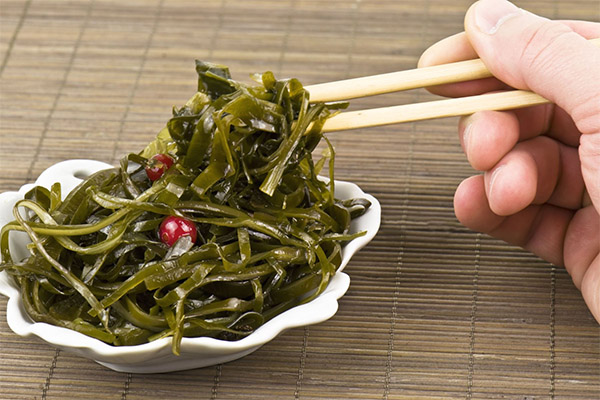
The substances contained in it participate in the process of hematopoiesis, ensure the functioning of the cardiovascular and nervous system.
For women
For the fair sex, seaweed is useful for several reasons at once:
- normalizes reproductive function;
- helps to lose weight;
- prevents premature aging;
- reduces the risk of cancer;
- supports the normal functioning of the thyroid gland.
In the absence of contraindications, it is recommended that women regularly include seaweed in the diet to reduce the risk of malignant tumors of the breast, uterus, and other organs of the reproductive system. This effect of kelp is due to its ability to normalize the level of estrogen in the body. And the action of sterols allows you to normalize your menstrual cycle.
For men
Representatives of the stronger sex often ignore seaweed - like any grass. But in fact, do not underestimate its benefits to the male body. The fact is that with the regular use of seaweed, physical performance increases. A series of experiments were carried out, which confirmed that kelp helps increase physical stamina and prevents the development of oxidative stress in the blood, characteristic of those who are engaged in such work.
Of course, iodine is just as important for men as it is for women. Indeed, the lack of this substance adversely affects both cognitive abilities and the state of the nervous system. Seaweed allows you to quickly make up for the lack of iodine, due to this, attention is improved, the reaction rate increases, which is important for sports and professional activities.
During pregnancy
Sea kale is useful even at the stage of pregnancy planning, not to mention the period of gestation. The fact is that it provides the body with a sufficient amount of folic acid, without which the normal development of the child is simply impossible. In addition, it contains a lot of healthy iodine, which is also necessary for normal gestation.
Finally, the substances contained in seaweed help cleanse the body of harmful toxins. And this seaweed is useful for cardiovascular activity. However, it should be remembered that during pregnancy you need to use any products, including seaweed, with caution, and at the first symptoms of an allergy, exclude it from the diet.
When breastfeeding
Seaweed contains not only iodine, but also beneficial amino acids, which, among other things, improve the absorption of this element. In the postpartum period, many women experience iodine deficiency, and when breastfeeding it becomes especially noticeable. So sea kale can significantly improve the situation.
Thanks to this product, hormonal levels normalize faster. Also, seaweed allows you to remove toxins and eliminate the depression characteristic of the postpartum period. Regular use of seaweed strengthens the bones of the mother and baby. In addition, these algae are useful in that they can reduce blood viscosity, and as a result, it has a beneficial effect on cardiovascular activity.
For kids
Children need vitamins and minerals, iodine also plays an important role in their development. But at the same time, you should not include seaweed in the diet of young children. Some pediatricians believe that it should not be offered to babies up to two years old, others believe that it is necessary to wait until three. The fact is that at an early age the child’s digestive system may simply not be able to cope with such a product, since the corresponding enzymes will not be produced.
At the same time, even older children should use cauliflower with caution. The fact is that there is always a risk of developing food allergies - therefore, it is necessary to introduce the product into the diet with caution.In addition, the child should not eat raw seaweed, since it is not known how it was stored in the store, how it was transported - during this time pathogenic microorganisms could have appeared in it.
For children, dried seaweed is considered the most beneficial option. Pediatricians recommend giving it in case of anemia, as well as to prevent diarrhea. In addition, dried seaweed is advised to be added to the diet in the treatment of childhood obesity.
If after three years of age there is some lag in physical and mental development, this may be due to a lack of iodine. Sea kale in this case may be the easiest solution to the problem.
Ideally, the pediatrician recommends boiling seaweed, as it does not have marinade that could harm the stomach. In addition, such a product is guaranteed to undergo heat treatment. True, far from always a child can be persuaded to eat just such a cabbage. Other options will be discussed below.
Seaweed chips: benefits and harms
It's no secret that not everyone likes the specific taste and aroma of this product, which is explained by the combination of sea salt and iodine. Nevertheless, there are cooking methods that can cope with this problem. In the East, thin plates are made from dried seaweed, which are eaten in their pure form, they also complement the first and second courses. And also in Asia they drink green tea, also rich in antioxidants.
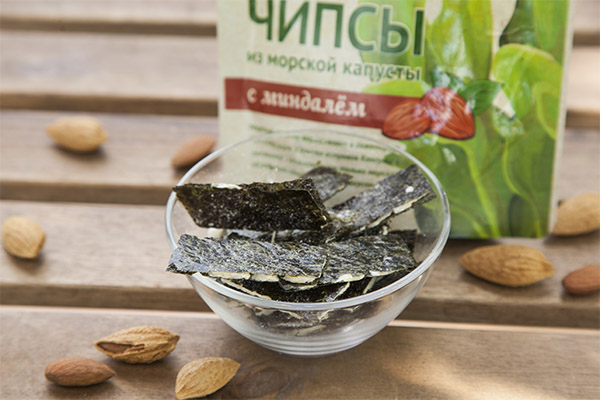
Thin plates are called chips. They can be useful - it all depends on how manufacturers tried to soften their taste and aroma. For example, seaweed chips cooked in sesame oil will be quite useful - unlike potato counterparts. However, this does not apply to spicy and salty sea kale chips. This is just not a bad snack.
Some companies produce chips with useful additives - wasabi, ginseng (they are very useful for increased physical exertion), with dried fruits or ginger. You should not get carried away with such chips, although their energy value is relatively small. The same rules apply for them as for sea kale in general, discussed below.
Is canned seaweed useful?
Sea kale is a source of iodine and retains its beneficial properties even when preserved. Of course, in this case it contains less vitamins, because some of them are destroyed after heat treatment. But for the most part, iodine is preserved, so that high-quality canned seaweed remains useful.
In cans, cabbage is sold seasoned with vegetable oil and onions, which increases its fat content. As for impurities, they are due to the fact that algae were mainly caught from the sea and managed to absorb those harmful elements that are contained in the water. These can be, for example, heavy metals or polychlorinated biphenyls. Fortunately, in most enterprises, raw materials are tested before being rolled into cans, so there is no health hazard.
Another important point is the salt content, in some producers it may be higher than normal, which levels the ability of seaweed to lower pressure. Vinegar-based marinades that are used for preservation can be harmful to the digestive system.
It should be noted that some companies have tried to reduce the damage caused by the processing characteristic of canning. Today, some of them use conservation technology. Vinegar is not used for it, only table salt and an antiseptic, the heat treatment is also minimal, and most importantly it is a dense package in a special container. As a result, seaweed retains all the beneficial substances. Such preserves are often produced with the addition of vegetables, fish and seafood, meat and pickled beets, garlic, tomato sauce.
The benefits and harms of dried seaweed
Dried seaweed keeps all the beneficial properties fresh. It consists of 5-20% vegetable protein, 6-12% of carbohydrates, and iodine contains up to 0.6%. At the same time, it contains other vitamins and minerals, it has a low energy value, so it is often recommended to be used for fasting days.
The fact is that dried seaweed is subjected to only a small heat treatment. But this stage cannot be avoided, since fresh kelp consists almost entirely of water. When drying, excess moisture leaves it, and all useful properties remain.
Is it possible to eat sea kale for weight loss
Seaweed is considered an excellent dietary product that can and should be consumed to reduce weight and treat obesity. This is due to its composition, as well as the presence of anti-inflammatory properties (the latter are very important in cases where there is a relationship between excess weight and diabetes).
Theoretically, in order to get rid of extra pounds, it is enough just to eat up to 50 mg of dried kelp per day and at the same time adhere to a strict diet. If a person is not ready for this either physically or psychologically, a different approach can be used. Sea kale can be made the main component of the diet. The fact is that it contains almost all the substances necessary for the body, so such a diet will only be beneficial to health.
At the same time, seaweed contains fiber. In the stomach it swells, there is a feeling of its fullness, a feeling of hunger is dulled, appetite is reduced. But only sea kale needs to be prepared in advance, pouring cold water for 10 hours. After that, you need to cook it in the following way.
With this diet, seaweed can and should be combined with other products. The diet should include boiled eggs, as well as dietary meats. On one day, seaweed can be combined with eggs, on another - with meat. Drinking tea or a rosehip decoction is recommended. The diet must be followed for two weeks. If it is difficult to maintain such a diet so far, the duration can be reduced to one week. The maximum amount of seaweed is 300 g per day.
Also based on seaweed make wraps that allow you to reduce the volume of the hips and cope with cellulite.
Seaweed in medicine
The use of seaweed is considered proven - it is used for hypertension, arthritis, inflammatory gynecological diseases, etc. However, there are certain features of the use of seaweed in a particular case.

With diabetes
Sea kale for diabetes is very useful. The substances contained in it stimulate the synthesis of insulin and normalize the work of the pancreas and parathyroid gland, therefore, diabetics are not just possible, but literally need to use it on a regular basis. Moreover, it contains tartanic acid, which prevents the deposition of bad cholesterol and helps to lose weight - both of which are very important for diabetes.
Also, seaweed helps fight the complications of this disease. It helps prevent vision impairment and adrenal dysfunction, which are found in the development of diabetes. And seaweed improves cerebral circulation and has an anti-inflammatory effect, accelerates the healing of wounds and ulcers, which also plays an important role.
Important: glycemic index of seaweed - 22 units.
With pancreatitis
Sea kale has anti-inflammatory properties. But with an acute form of pancreatitis, it is not recommended to include it in the diet. It can be used only in the chronic form of the disease in remission. And it should be remembered that in this case, boiled or dried seaweed is included in the diet - the substances included in its composition will help normalize the function of the pancreas.But you can’t eat pickled, even if vinegar was not used for its preparation - it will cause increased production of pancreatic juice, which can cause an exacerbation of the disease.
With gastritis
This is an inflammatory disease, and with its exacerbation, seaweed cannot be eaten, only at the stage of stable remission. At the same time, it is advised to include boiled seaweed (for example, add it to soup) or dried cabbage, using it instead of salt.
For the intestines
Seaweed generally has a beneficial effect on the state of the human digestive system. But with inflammatory bowel diseases, the same restrictions apply as with the above pathologies of the pancreas and gastric mucosa. That is, seaweed is added to the diet only in the presence of a stable remission and only in boiled or dried form.
For constipation
As noted above, seaweed contains polysaccharides. They are prebiotics, that is, they create a favorable environment for the reproduction of beneficial intestinal microflora. That is why seaweed is considered an effective remedy for constipation caused by dysbiosis or irritable bowel syndrome.
However, seaweed has another mechanism of action that puts it on a par with the most effective mild laxatives. Thanks to this mechanism, it helps with functional constipation, which are associated with impaired bowel receptor function. Fiber contained in seaweed swells in the stomach, and it enters the intestines, having already greatly increased in volume. This leads to irritation of the receptors, which causes bowel movement. Moreover, unlike many other means, seaweed is not addictive, it just helps the intestine to fulfill its duties, and therefore the product can be included in the diet on a regular basis.
With gout
This disease is associated with a violation of salt metabolism. When it occurs, the deposition of crystals of uric acid salts in certain joints. Sea kale helps prevent the formation of such complications. A specific recipe for its use will be discussed below.
With colitis
This disease is associated with inflammatory processes in the intestines. Cabbage in the stomach swells, and, moving further along the digestive tract, irritates the receptors of the mucosa. Therefore, with an acute form of colitis (or with an exacerbation of a chronic disease), it is contraindicated.
For the liver
Sea kale is very beneficial for the liver. It contains various polysaccharides, of which alginic acid and mannitol are the most valuable for the liver. The latter is widely used in pharmacology, since it plays the role of an enterosorbent that neutralizes and removes toxins. But at the same time, mannitol stimulates bile secretion.
As for alginic acid, it can also bind and excrete from the body some substances hazardous to it, in particular, salts of heavy metals. Thus, both of these components help the liver to perform its functions, providing it with additional protection.
Laminaria, among other things, contains many plant proteins, antioxidants, minerals and fats, which also have beneficial effects on liver cells.
With hemorrhoids
Despite the fact that, in general, seaweed has a beneficial effect on the state of the intestine, it is contraindicated in hemorrhoids.
With cholecystitis
If this disease is not accompanied by the formation of stones, then there is no reason to refuse seaweed. On the contrary, it will be very useful because it will help get rid of edema and remove toxins. Also, seaweed with this disease can partially replace the prohibited salt.
Seaweed based traditional medicine recipes
In China, seaweed has been used as a medicinal plant for centuries. In domestic folk medicine, she is given a somewhat more modest role. Nevertheless, seaweed can be used for a wide variety of pathologies.
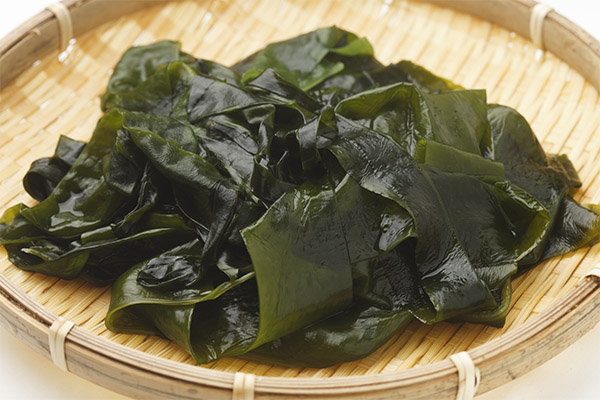
Recipes:
- For diseases of the upper respiratory tract, seaweed is recommended for inhalation. To do this, take 2 tbsp. dry raw materials, pour 1 liter of boiling water and insist for 10-15 minutes. This is best done in a teapot - when the mixture is infused, a sheet of paper rolled into a cone is inserted into its spout and breathe steam over it for 10–20 minutes.
- The infusion of kelp will help with rheumatism and inflammatory joint diseases. To do this, take 2 tbsp. dry kelp and insist in a thermos for 12 hours. Then they take a bath, pouring the obtained infusion into hot water.
- With gout, a product based on seaweed is taken orally. To do this, take 1 tsp. without slide, chopped dry laminaria with 150 ml of hot water (not boiling water). The tool is insisted until it cools down. Take it at night, but given the fact that it can act as a mild laxative.
- To combat atherosclerosis, take 1 tsp. dry kelp powder and pour 50 ml of boiling water. Insist until it cools down. The entire volume is divided into three equal parts and taken three times a day before meals.
Seaweed in cosmetology
Sea kale is widely used in cosmetology. It is mainly useful in that it helps to establish the work of the sebaceous glands. In this regard, masks based on seaweed are used to treat acne. Also, due to the high concentration of vitamins, minerals and hormone-like substances, they rejuvenate the skin, tighten it, and improve the oval of the face. In short, the importance of this algae in cosmetology is difficult to overestimate.
For face
Various masks are made for the face based on seaweed that relax muscles, tone the skin, nourish and moisturize it, help cleanse pores and remove dead cells, and even provide regeneration to a certain extent. Examples of such recipes include:
- Anti-aging mask. For 3 tsp dry kelp take 5 tsp boiling water and thoroughly mix the ingredients until smooth. The container is tightly closed with a lid so that the mixture is infused. This will take 10 minutes - a slimy mass should remain in the container, into which several drops of freshly squeezed lemon juice are added and mixed. The product is applied to cleansed skin and left for 30 minutes. Then wash off with warm, but not hot water. The mask is made three times a week, more often it is not necessary, especially since the lemon gives a certain whitening effect.
- Nourishing mask based on seaweed, peach oil and honey is suitable for dry skin. Take 1 tsp. dried seaweed, pour so much water so that with stirring a mass is obtained that is similar in texture to a cream. Then add 1.5 tsp to this composition. peach seed oil and as much honey. The product is mixed and applied to cleansed skin for 20 minutes, and then washed off with warm water.
- Whitening mask based on seaweed. Take 1 tbsp. swollen raw materials (from dry kelp), add a little fresh lemon juice and 1 tbsp. sour cream. Apply the mixture to pre-cleansed skin and leave for 10 minutes, then rinse with non-hot water.
There are many variations on the subject of such masks. For example, for normal skin, a nourishing mask is prepared not only on the basis of seaweed and peach oil, but also with the addition of raw egg white and lemon juice. With problem skin prone to inflammation - use aloe juice.
For hair
Sea kale, rich in vitamins and minerals, can accelerate hair growth, including by improving the blood supply to the hair follicles, and also nourishes the scalp and helps get rid of seborrhea. The following tools are used for this:
- Mask for hair growth. 2 tbsppowder of dry seaweed take 100 ml of water (and it is better to take mineral, but not carbonated), 2 tsp. burdock oil. Some recipes add onion juice, but this is optional. Sea kale is pre-filled with water (about 1.5 hours before applying the mask). The oil is slightly heated in a water bath, then the components are mixed and applied to the scalp and the entire length of wet hair. Be sure to lightly massage the skin. After this, the head is wrapped in plastic wrap and a towel to create a greenhouse effect. After 40 minutes, the mask is washed off. If onion juice was used, then you can not hold longer than 20 minutes, otherwise the skin will be burned.
- Mask for strengthening hair. Take 2 tbsp. powder based on seaweed, as much colorless henna, a glass of water to dilute these components. Dry components are diluted with water separately, then combined, thoroughly mixed. Then put in the composition of 1-2 tsp. coconut oil pre-melted in a water bath. Apply to wet hair along the entire length for half an hour.
Both masks are washed off with shampoo, and then rinsed with water and a little lemon juice. This fixes the effect and helps get rid of bad smell.
Harm and contraindications
Many fear that eating seaweed may cause iodism. In fact, this disease is more associated with the use of inorganic iodine. And the element that is contained in seaweed is perfectly absorbed by the body and does no harm. But this product has its own side effects and contraindications.
Sea kale is strictly contraindicated:
- with urticaria;
- tuberculosis
- furunculosis;
- hemorrhagic diathesis;
- pathologies of the endocrine system;
- chronic rhinitis.
Also, it is not recommended to use it during exacerbation of renal diseases and pathologies of the digestive tract.
Symptoms of seaweed allergy
Mostly allergic reactions occur in people who are hypersensitive to iodine. In this case, the symptoms can be purely external - this is hives or other types of allergic rashes, accompanied by the appearance of itching. But in some cases the problem can be more serious - shortness of breath, swelling, severe rhinitis, in severe cases - bronchospasm and Quincke's edema. In the presence of such reactions, you must stop contact with the allergen and take an antihistamine.
How to choose and store seaweed
To choose seaweed, you need to know what to look for. If we are talking about frozen cabbage or preserves described above, then it is worth giving preference to the product in a transparent package, since it will be easier to consider:
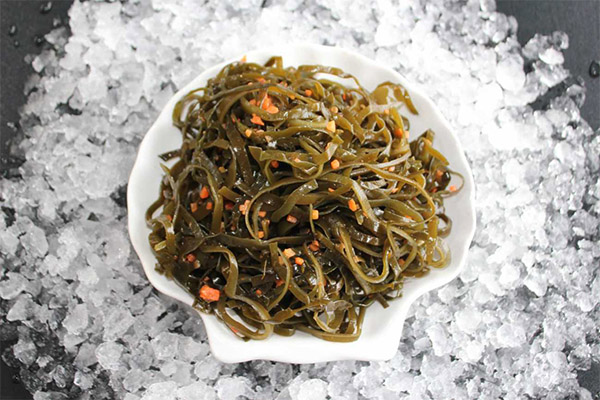
- When choosing frozen seaweed, it is important to consider: in the bag, it should have a pronounced straw shape of dark green color. The yellowed product is most likely spoiled. Bright green color indicates a fake. In no case should you buy a mess. If ice is noticeable in the bag, you should also refuse to buy. The thicker the straws of sea kale, the better - this means that the seaweed has ripened for a long time and contains many vitamins.
- When choosing pickled seaweed, it is also recommended to give preference to transparent packaging in order to consider the texture - it should be clear. The packaging should indicate the origin of the algae. The Barents Sea is not considered the best option, the ideal product should come from the Pacific Ocean, and it can be produced both in Russia and China - this does not really matter. Cabbage should be covered with brine for a third and no more. The composition may include additives - vegetable oil, spices, lemon juice. What should not be in it is vinegar and preservatives. Food supplement E211 is considered approved by the Ministry of Health, but it destroys those nutrients that are contained in seaweed.
- Dried seaweed is sold by weight or in bags. The second option is considered preferred. The package must be intact, without any signs of damage. If it is transparent, you can purely visually check that there are no impurities in its contents.Dried kelp plates should not be glued together.
Sea kale can also be purchased at cans. The advantages of such canned foods are that they underwent heat treatment, so they add less preservatives. However, in fact, the buyer gets a "pig in a poke", because he can not look inside the can.
Do not buy seaweed by weight. So the buyer simply does not know what spices and additional ingredients were used in the manufacture of the product.
Storage conditions depend on both the type of cabbage and its packaging. For example, frozen seaweed can be stored in the freezer for a long enough time - up to 30 days. Canned food in the refrigerator, if they were packed in plastic, are stored up to 72 hours after opening. After opening the product in a tin can, it is recommended to transfer it to a glass container, where it can be stored for no more than two days (of course, in the refrigerator). Dried seaweed is stored in a dark, dry and cool place. Shelf life is 3 years.
Is it possible to freeze
Sea kale can be frozen - it does not lose its beneficial properties. Shredded kelp is frozen in briquettes at a temperature of -15-18 ° C, but this is most often carried out in an industrial environment.
How to dry seaweed
Theoretically, sea kale can be dried at home, but only if it is possible to arrange a suitable place for drying. It should be a rocky area, protected from the wind. It will be necessary to install a canopy on it, since the technology involves the natural drying of kelp.
It is recommended to put the flooring on the site, its height should be 15–20 cm above the ground. Before laying out the algae, it should be washed with water and treated with some kind of disinfectant.
Laminaria should be thoroughly washed in sea water so that there is no sand or other natural contaminants left on it. Petioles need to be cut. Algae should be sorted, leave only whole. For drying, they need to be carefully decomposed and straightened. In order for the process to proceed under natural conditions, drying should be done only in good weather, and algae should be laid out on the flooring in the early morning. If you do this later, the upper layers of seaweed will be overdried. In addition, the most valuable part — thalli — can curl. Interestingly, most often this happens in the morning, so you need to turn them over every 2-3 hours.
In general, the most productive period for drying is considered to be a sunny day from 8 a.m. to 3 p.m. During this time, algae lose up to 70% moisture. Sea kale in this case acquires a smooth surface on which no salt deposits are visible. It can be stored for a long time. At night, it should be removed under a canopy, and in the morning it will be possible to lay out only when the site dries from dew. As a rule, algae can be dried in two days. Drying seaweed for longer is not recommended, as mold may appear on it.
How to cook seaweed: recipes
Salads are most often prepared from pickled or boiled seaweed, trying to soften the specific taste and smell of the product. In addition, kelp can be added to various vegetable, meat and fish dishes, it is combined with seafood. In Russian cuisine, it is added to traditional soups - for example, cabbage soup or pickle. You can cook with it and vegetable stew, which seaweed gives a slightly unusual taste.
But no matter what dish you cook with it, you need to properly prepare the raw materials. So, frozen seaweed must first be washed in running water and then cook literally for 1-3 minutes.
With dried seaweed, there will be more work. First, it should be washed in cold water, then soaked for 10-12 hours so that it swells. The recommended proportion is 5–6 parts of liquid per 1 part of kelp. Water can be taken both fresh and slightly salted. Then this mixture should be brought to a boil and left on low heat for 15-20 minutes.Drain the broth, boil the kelp again. This can significantly improve its taste and aroma. When the seaweed is ready, it can be poured with mushroom brine - the taste will be unusual, but spicy and pleasant.
Experienced chefs offer such recipes.
Salad with seaweed, potatoes and eggs
This is a great option for the winter menu, when the diet lacks vitamins. For 300 g of pickled seaweed take 4 eggs, 1 sour apple, 1 boiled potato, 2-3 tbsp. olive oil for refueling. Salt can not be added to such a salad. Spread seaweed in a salad bowl, add pre-chopped boiled eggs, an apple, chopped into strips and sprinkled with lemon juice, and finely chopped potato. You can add the leaves of a regular salad. In some recipes, eggs are recommended to be cut into large slices and decorate with a dish.
Frozen Seaweed Salad
For cooking, you will need: 200 g of frozen sea kale, 100 g of white cabbage (can be replaced with Peking), 1 fresh cucumber (it is better to take the so-called "English" - long and with a smooth skin), herbs, a little salt or herbs, olive oil for refueling. Sea kale should thaw, after which it is washed, chopped and boiled in slightly salted water for no longer than 15–20 minutes. Then the liquid is drained, and the cabbage is thrown into a colander, cooled, mixed with chopped vegetables, watered with dressing and sprinkled with chopped herbs.
Pickle with seaweed
For cooking, you will need 200 g of pickled kelp, 1 potato, 1 carrot, 1 medium onion, 3-4 pickles, 1 tsp. butter, salt and sour cream to taste. The pickle is prepared in the traditional way. You can add rice or pearl barley to it. Passer cabbage, add to the already boiling pickle and cook for 3-5 minutes. Served to the table with sour cream.
Omelet with cabbage
Children can be given scrambled eggs with seaweed. You need to take 2 eggs, beat, pour 30 ml of milk into a container with them and beat thoroughly, and add 2 tsp immediately before baking in the oven. dry seaweed pre-flooded with warm water to swell. Omelet is cooked in the oven or in the microwave for 4–5 minutes, then spread on a plate with vegetables and offered to the baby.
How to eat seaweed
This product is consumed in boiled, stewed, dried form. Not everyone tolerates the taste and smell of seaweed. To get the benefit, you can add it instead of salt to soups, fish dishes and salads - it practically does not affect the taste.
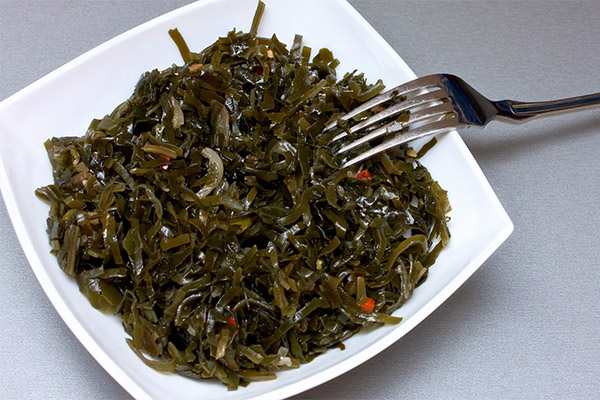
How much can you eat per day
An adult can eat up to 250-300 g of seaweed in a boiled, stewed or pickled form per day. The maximum amount of dry kelp due to the higher iodine concentration is 2 tsp.
Children are advised to eat no more than 15 g of seaweed per day. Gradually, the amount can be increased, but taking into account the fact that up to 60 g of kelp can be eaten per week. This applies to boiled or braised kelp. In dry form, the maximum dosage is 1 tsp. in a day.
Can I eat at night
Sea kale is a low-calorie product, it is easily and quickly digested, it can be eaten at any time of the day. Some nutritionists even believe that at night this product is useful for those who suffer from constipation - the desired effect of kelp will give just in the morning.
Is it possible to eat raw
It is not recommended to eat raw seaweed in raw form, and this is not practical, since it consists almost entirely of water. Therefore, kelp is eaten only in boiled, stewed, pickled form.
Is it possible to eat sea kale in the post
During Great Lent, seaweed is allowed.And this is very good, because throughout the post, severe restrictions on seafood can lead to iodine deficiency.
Is it possible to give animals seaweed
Sea kale is useful not only for people, but also for animals. For pets, it is also an indispensable source of iodine. This element has a beneficial effect on the condition of the skin and coat, strengthens the immune system and increases resistance to infectious diseases. Iodine is especially useful for dogs, it has a calming effect, which is very good for excitable animals. In addition, pets who regularly receive seaweed with food are less likely to undergo parasitic infestations.
However, dog owners should be aware that when iodine is added to the animal’s diet, this substance affects the color of the animal’s coat, enhancing its pigmentation. That is, if in normal condition the dog is distinguished by a reddish or brownish shade of hair, then with regular use of sea kale, the color will become even brighter and more saturated. But that is not the problem. The coat of snow-white animals when using this product begins to turn a little yellow. It may even be imperceptible if you do not compare such an animal with its normal relatives. For an ordinary dog, this may not be so important, but for those who participate in exhibitions, this is a fundamental point. Moreover, the color is displayed quite quickly, so the main thing is not to give kelp immediately before the exhibition.
The animals are given mainly dried seaweed, which should first be crushed. Such supplements are usually sold in pharmacies.
Dogs are advised to give kelp from the moment they turn 1.5–2 months old. The initial dosage should be minimal - literally on the tip of the knife. The dose is increased gradually, and by the year representatives of medium breeds can be given 1 tsp. dried seaweed, and large animals - and 1.5–2 tsp But, of course, they are not added to the diet every day, but in one feeding at most twice a week.
Interesting facts about seaweed
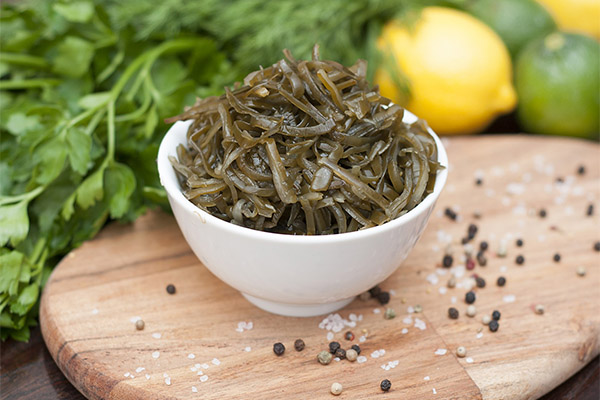
- Seaweed is algae, which is why it contains so many biologically active substances. In particular, science has proved that marine plants contain 2–3 times more vitamins than terrestrial ones.
- Brown seaweed, from which frozen and dry seaweed is prepared, is collected mainly from the ship, since on the surface they appear only during a large tide.
- At the same time, farms are gradually developing where sea cabbage is grown. The fact is that kelp can be called the fastest growing culture in the world. The experiments conducted in China showed that up to 500 tons of algae can be obtained from one marine hectare, which exceeds the results of any crop.
- When collecting any algae, one should adhere to many rules in order to preserve their healing properties. Whole thalli of kelp are considered the most useful, they are trying to be sure to keep them, preventing the drying of algae. However, it is difficult to transport them, which is why in cosmetology, and in cooking, a cheaper option is often offered, which is crushed particles of dried seaweed.
«Important: all information on the site is provided exclusively in fact-finding purposes. Before applying any recommendations, consult with a profile specialist. Neither the editors nor the authors are liable for any possible harm caused materials. "

